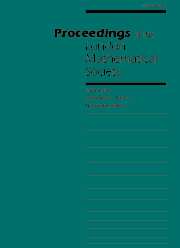Entropy and collapsing of compact complex surfaces
Published online by Cambridge University Press: 05 November 2004
Abstract
We study the problem of existence of $\mathcal{F}$-structures (in the sense of Cheeger and Gromov, but not necessarily polarized) on compact complex surfaces. We give a complete classification of compact complex surfaces of Káhler type admitting $\mathcal{F}$-structures. In the non-Káhler case we give a complete classification modulo the gap in the classification of surfaces of class VII.
We then use these results to study the minimal entropy problem for compact complex surfaces: we prove that, modulo the gap in the classification of surfaces of class VII, all compact complex surfaces of Kodaira dimension less than or equal to 1 have minimal entropy zero and such a surface admits a smooth metric $g$ with zero topological entropy if and only if it is ${\mathbb C} P^2$, a ruled surface of genus 0 or 1, a Hopf surface, a complex torus, a Kodaira surface, a hyperelliptic surface or a Kodaira surface modulo a finite group. The key result we use to prove this is a new topological obstruction to the existence of metrics with vanishing topological entropy.
Finally we show that these results fit perfectly into Wall's study of geometric structures on compact complex surfaces. For instance, we show that the minimal entropy problem can be solved for a minimal compact Káhler surface $S$ of Kodaira dimension $- \infty$, 0 or 1 if and only if $S$ admits a geometric structure modelled on ${\mathbb C} P^2$, $S^2 \times S^2$, $S^2 \times {\mathbb E}^2$ or ${\mathbb E}^4$.
Keywords
- Type
- Research Article
- Information
- Proceedings of the London Mathematical Society , Volume 89 , Issue 3 , November 2004 , pp. 763 - 786
- Copyright
- 2004 London Mathematical Society
Footnotes
- 10
- Cited by


